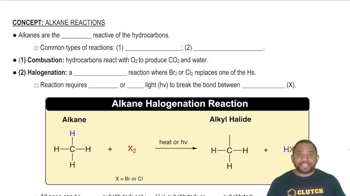Here are the essential concepts you must grasp in order to answer the question correctly.
Balancing Chemical Equations
Balancing chemical equations involves ensuring that the number of atoms for each element is the same on both sides of the equation. This is based on the law of conservation of mass, which states that matter cannot be created or destroyed in a chemical reaction. To balance an equation, coefficients are adjusted in front of the chemical formulas to achieve equal atom counts.
Recommended video:
Balancing Chemical Equations
Types of Chemical Reactions
The reaction represented in the equation is a decomposition reaction, where a single compound breaks down into two or more products. Understanding the type of reaction helps in predicting the products formed and the conditions required for the reaction to occur. In this case, ammonium nitrate decomposes into nitrogen gas, oxygen gas, and water.
Recommended video:
Common Types of Alkane Reactions
Stoichiometry
Stoichiometry is the quantitative relationship between reactants and products in a chemical reaction. It allows chemists to calculate the amounts of substances consumed and produced in a reaction. In balancing the equation, stoichiometric coefficients indicate the ratio of moles of each substance, which is essential for accurate calculations in chemical processes.
Recommended video:




